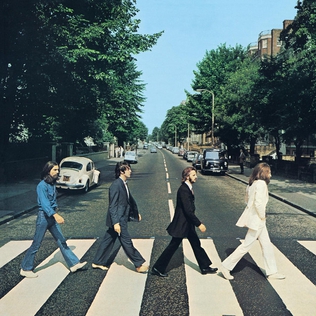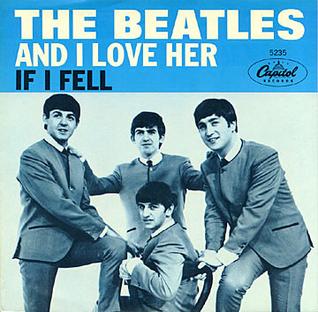Related Research Articles

The Beatles, also known colloquially as the White Album, is the ninth studio album and only double album by the English rock band the Beatles, released on 22 November 1968. Featuring a plain white sleeve, the cover contains no graphics or text other than the band's name embossed. This was intended as a direct contrast to the vivid cover artwork of the band's previous LP Sgt. Pepper's Lonely Hearts Club Band. The Beatles is recognised for its fragmentary style and diverse range of genres, including folk, British blues, ska, music hall, pre-heavy metal and the avant-garde. It has since been viewed by some critics as a postmodern work, as well as one of the greatest albums of all time.

Let It Be is the 12th and final studio album by the English rock band the Beatles. It was released on 8 May 1970, almost a month after the group's break-up, in tandem with the documentary of the same name. Concerned about recent friction within the band, Paul McCartney had conceived the project as an attempt to reinvigorate the group by returning to simpler rock 'n' roll configurations. The album topped charts in many countries, including both the UK and the US, but the critical response was generally unfavourable, and Let It Be came to be regarded as one of the most controversial rock albums in history.

Abbey Road Studios is a recording studio at 3 Abbey Road, St John's Wood, City of Westminster, London, England. It was established in November 1931 by the Gramophone Company, a predecessor of British music company EMI, which owned it until Universal Music Group (UMG) took control of part of it in 2013. It is ultimately owned by UMG subsidiary Virgin Records Limited.

Abbey Road is the eleventh studio album released by the English rock band the Beatles. It is the last album the group started recording, although Let It Be was the last album completed before the band's break-up in April 1970. It was mostly recorded in April, July and August 1969, and was released on 26 September 1969 in the United Kingdom, and 1 October 1969 in the United States, reaching number one in both countries. A double A-side single from the album, "Something" / "Come Together" was released in October, which also topped the charts in the US.

The Complete Beatles Recording Sessions is a reference book on the English rock band the Beatles compiled by author Mark Lewisohn. Hamlyn published it in the UK in 1988 and Harmony Books published it in the US.
Automatic double-tracking or artificial double-tracking (ADT) is an analogue recording technique designed to enhance the sound of voices or instruments during the mixing process. It uses tape delay to create a delayed copy of an audio signal which is then combined with the original. The effect is intended to simulate the sound of the natural doubling of voices or instruments achieved by double tracking. The technique was developed in 1966 by engineers at Abbey Road Studios in London at the request of the Beatles.

"Tomorrow Never Knows" is a song by the English rock band the Beatles, written primarily by John Lennon and credited to Lennon–McCartney. It was released in August 1966 as the final track on their album Revolver, although it was the first song recorded for the LP. The song marked a radical departure for the Beatles, as the band fully embraced the potential of the recording studio without consideration for reproducing the results in concert.

Ken Scott is a British record producer and engineer known for being one of the five main engineers for the Beatles, as well as engineering Elton John, Pink Floyd, Procol Harum, Mahavishnu Orchestra, Duran Duran, the Jeff Beck Group and many more.

"You Never Give Me Your Money" is a song by the English rock band the Beatles. It was written by Paul McCartney and documented the financial and personal difficulties facing the band. The song is the first part of the medley on side two of their 1969 album Abbey Road and was recorded in stages between May and August that year.

"And I Love Her" is a song recorded by English rock band the Beatles, written primarily by Paul McCartney and credited to the Lennon–McCartney partnership. It is the fifth track of their third UK album A Hard Day's Night and was released 20 July 1964, along with "If I Fell", as a single release by Capitol Records in the United States, reaching No. 12 on the Billboard Hot 100.

"Hey Bulldog" is a song by the English rock band the Beatles released on their 1969 soundtrack album Yellow Submarine. Credited to Lennon–McCartney, but written primarily by John Lennon, it was finished in the recording studio by both Lennon and Paul McCartney. The song was recorded during the filming of the "Lady Madonna" promotional film, and, with "Lady Madonna", is one of the few Beatles songs based on a piano riff.
Ken Townsend MBE, is an English sound engineer who played an important role at Abbey Road Studios. He worked on several Beatles albums, such as Rubber Soul, Revolver and Sgt. Pepper's Lonely Hearts Club Band. In 1966 he invented artificial double tracking (ADT). He spent his whole working career at EMI, and retired as the Chairman of the Studio Group after 42 years of service.

Alan Parsons is an English audio engineer, songwriter, musician and record producer.

The studio practices of the Beatles evolved during the 1960s and, in some cases, influenced the way popular music was recorded. Some of the effects they employed were sampling, artificial double tracking (ADT) and the elaborate use of multitrack recording machines. They also used classical instruments on their recordings and guitar feedback. The group's attitude towards the recording process was summed up by Paul McCartney: "We would say, 'Try it. Just try it for us. If it sounds crappy, OK, we'll lose it. But it might just sound good.' We were always pushing ahead: Louder, further, longer, more, different."

Recording The Beatles is a book by Kevin Ryan and Brian Kehew, published by Curvebender Publishing in September 2006. Written over the course of a decade, the book addresses the technical side of the Beatles' sessions and was written with the assistance of many of the group's former engineers and technicians, chief among them Peter K. Burkowitz, designer of the REDD mixing console.
The recordings made by the Beatles, a rock group from Liverpool, England, from their inception as the Quarrymen in 1957 to their break-up in 1970 and the reunion of their surviving members in the mid-1990s, have huge cultural and historical value. The studio session tapes are kept at Abbey Road Studios, formerly known as "EMI Recording Studios," where the Beatles recorded most of their music. While most have never been officially released, their outtakes and demos are seen by fans as collectables, and some of the recordings have appeared on countless bootlegs. Until 2013, the only outtakes and demos to be officially released were on The Beatles Anthology series and its tie-in singles and anniversary editions.Bits of some previously unreleased studio recordings were used in The Beatles: Rock Band video game as ambient noise and to give songs studio-sounding beginnings and endings. In 2013, Apple Records released the album The Beatles Bootleg Recordings 1963, which includes previously unreleased outtakes and demos from 1963, to stop the recordings from falling into the public domain.

An audio engineer helps to produce a recording or a live performance, balancing and adjusting sound sources using equalization, dynamics processing and audio effects, mixing, reproduction, and reinforcement of sound. Audio engineers work on the "technical aspect of recording—the placing of microphones, pre-amp knobs, the setting of levels. The physical recording of any project is done by an engineer... the nuts and bolts."
Peter Mew is a retired British music audio engineer. He worked at Abbey Road Studios, where he was the senior mastering engineer. He came to Abbey Road in 1965 as a tape operator and has since worked with many artists at the studio. Kevin Ayers of Soft Machine has called Mew "the best engineer I've ever worked with".
Send tape echo echo delay is a technique used in magnetic tape sound recording to apply a delay effect using tape loops and echo chambers.
Peter Cobbin is an Australian audio engineer and producer. He served as chief engineer of Abbey Road Studios from 1995 to the mid-2010s, during which he became the first engineer to remix music by the Beatles, remixing their 1999 compilation album Yellow Submarine Songtrack. He has recorded and mixed scores for a number of films, including The Lord of the Rings: The Return of the King (2002), several entries in the Harry Potter and Wizarding World franchise, and the Hobbit trilogy (2012–14).
References
Citations
- ↑ Leyshon, Andrew (2014). Reformatted: Code, Networks, and the Transformation of the Music Industry. Oxford University Press. p. 122. ISBN 978-0-199-57241-0.
- ↑ MacDonald 1997, p. 439.
- ↑ Ryan, Kevin; Kehew, Brian (2006). Recording the Beatles: the studio equipment and techniques used to create their classic albums. Curvebender. p. 43. ISBN 978-0-978-52000-7.
- ↑ Soundtrack Nation: Interviews with Today's Top Professionals in Film, Videogame, and Television Scoring. Cengage Learning. 2010. p. 135. ISBN 978-1-435-45762-1.
- ↑ MacDonald 1997, p. 311.
- ↑ "Alan Parsons: Life after Abbey Road". Tape Op Magazine. 15 July 2004. Retrieved 10 February 2015.
- ↑ Senior, Mike (2011). Mixing Secrets for the Small Studio. Taylor & Francis. p. 80. ISBN 978-0-240-81580-0.
Sources
- MacDonald, Ian (1997). Revolution in the Head: The Beatles' Records and the Sixties (First Revised ed.). London: Pimlico (Random House). ISBN 978-0-7126-6697-8.